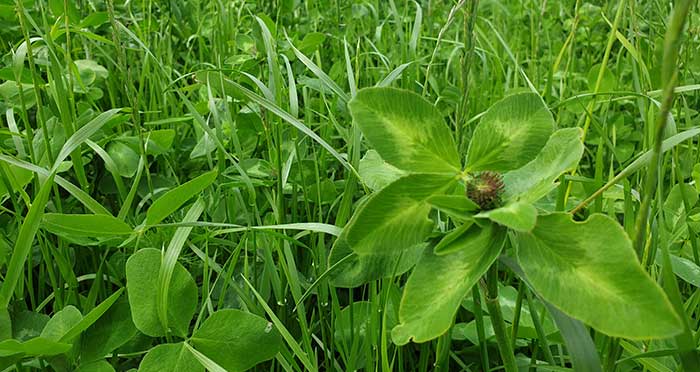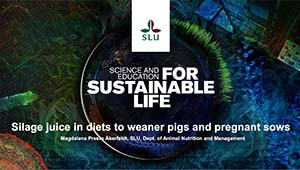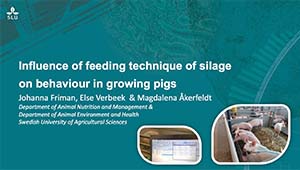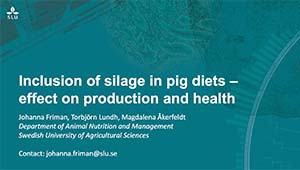Increased utilization of ley crops in feed for organic pigs

Feeding strategies and influence of dietary inclusion of grass/clover silage on production, fertility, N-emission and pig behaviour
Ley crops can to some extent replace other protein sources for pigs. The ley has positive effects in the crop rotation, but there is little knowledge about feeding silage to pigs. In what form should it be fed? How does it affect growth, behaviour, fertility and production economy? In a recently granted project from Formas, we will be able to study this during four years.
Evaluating green protein from ley crops to monogastric animals is interesting and is ongoing in several research projects in Europe. In this project, we will focus on evaluating the inclusion of silage in diets to pigs, as it is of interest to evaluate how to utilise the ley at farm level.
The aim of the project is to evaluate the usefulness of grass/clover silage as a locally grown feed resource in organic pig production. Limited access to high quality organic protein feed makes it necessary to find and evaluate alternative feed sources for organic pigs. Ley crops also gives the pigs an increased opportunity to perform natural behaviours and there are studies showing that the gut microbes are involved in the development of both nervous system and brain. A fibre-rich diet can thus reduce both stress and illness among the pigs. In the granted project, an overall approach is taken to the question of increased utilisation of ley crops in diets to organic pigs.

We will evaluate in what form the silage should be fed and how it can be applicable in practice, how well the pigs can utilize the nutrition and how it affects production, fertility, behaviour and Nitrogen excretion in the manure. We will also investigate how the production economy is affected by the increased use of ley crops. Our expectation is to be able to give clear and safe recommendations to farmers and advisers and to promote the development towards more locally and sustainably produced feed.
The specific parts of the project include:
1. Pre-treatment of ley crop silage on pig performance and behaviour.
2. The N use efficiency at pig and farm level and environmental impact of N in faeces and urine and influence
on NH losses at high dietary inclusion of ley crop silage to pigs.
3. Relationships between ley crops diets, pigs' explorative behaviour and the microbiota-gut-brain axis.
4. The metabolism and biological effects of phytoestrogens in sows fed red clover silage.
5. The farm level economic effects of introducing ley in the feed regimen in piglet and slaughter pig
production and to account for the structural differences between those two production types.
Project manager:
Magdalena Åkerfeldt, magdalena.akerfeldt@slu.se
Doctoral student:
Johanna Friman, johanna.friman@slu.se
Doctoral student:
Emy Vu, emy.vu@slu.se
Head supervisor:
Magdalena Åkerfeldt
Project group:
Magdalena Åkerfeldt, SLU
Johan Dicksved, SLU
Ann-Sofi Bergqvist, SLU
Eva Salomon, RISE
Linda Keeling, SLU
Else Verbeek, SLU
Helena Hansson, SLU
Ylva Sjunnesson, SLU
Reports:
Minskad klimatpåverkan med vallfoder till gris – beräkning av klimatavtrycket ur ett livscykelperspektiv. Elin Röös, Stanley Zira, Eva Salomon och Magdalena Åkerfeldt. Mistra Food Futures Report #11, 2022. Abstract in English.
Publications:
J. Friman, E. Verbeek, A. Sannö & M. Presto Åkerfeldt. 2024.
Inclusion of silage in diets to fattening pigs: effect on gastric ulcers and skin lesions. Animal, Vol. 18, Issue 1, 101045.
Johanna Friman, Kristina Mjöfors, Eva Salomon & Magdalena Presto Åkerfeldt. 2023. Feeding silage to fattening pigs – effects on nitrogen utilization and ammonia losses from fresh manure. Acta Agriculturae Scandinavica, Section A — Animal Science.
Zira, S., Salomon, E., Åkerfeldt, M. & Röös, E. Environmental consequences of pig production scenarios using biomass from rotational grass-clover leys as feed, Environmental Technology & Innovation, Volume 30, 2023, 103068.
Friman, J., Lundh, T. & Presto Åkerfeldt, M. 2021. Grass/clover silage for growing/finishing pigs – effect of silage pre-treatment and feeding strategy on growth performance and carcass traits. Acta Agriculturae Scandinavica, Section A — Animal Science, DOI: 10.1080/09064702.2021.1993319
Presto Åkerfeldt, M., Holmström, S., Wallenbeck, A. and Ivarsson, E. 2020. Inclusion of intensively manipulated silage in total mixed ration to growing pigs – influence on silage consumption, nutrient digestibility and pig behaviour. Acta Agriculturae Scandinavica, Section A — Animal Science.
https://doi.org/10.1080/09064702.2020.1725104
Doctoral thesis:
Ley crop silage in diets to fattening pigs : How does it affect pig performance, nitrogen utilization, health and behaviour? Johanna Friman. 2023.
Individual project works (in Swedish)
Red clover silage to sows – effects on the production, reproductive organs, farrowing behaviour and farrowing course. Sandra Edvardsson, 2023
Feeding silage to fattening pigs – effects on meat quality and fatty acid composition. Erika Ohlsson, 2022
Phytoestrogens in red clover and its impact on pigs and ruminants. Desirée Kristiansson & Linda Larsson, 2022
Presentations
EAAP 2022
Silage juice in diets to weaner pigs and pregnant sows. Book of Abstracts, session 39. EAAP 2022. Presentation (pdf).
Silage juice in diets to weaner pigs and pregnant sows. Book of Abstracts, session 39. EAAP 2022. Abstract (pdf).
Influence of feeding technique of silage on behaviour in growing pigs. Presentation (pdf).
Influence of feeding technique of silage on behaviour in growing pigs. Book of Abstracts, session 50. EAAP 2022. Abstract (pdf).
EAAP 2021
Inclusion of silage in pig diets – effect on production and health. Presentation (pdf).
Inclusion of silage in pig diets – effect on production and health. Book of Abtracts, session 31. EAAP 2021. Abstract (pdf).
DPP 2022
Reduced occurrence of gastric ulcer in silage fed pigs. Poster (pdf).
Reduced occurrence of gastric ulcer in silage fed pigs. Abstract (pdf).


